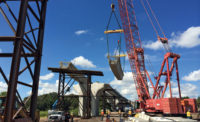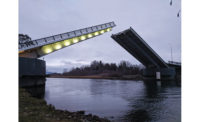Answering a call from the Federal Highway Administration, a group of steel-bridge advocates have introduced a new type of tub girder that requires less fabrication and installation time.
The Short Span Steel Bridge Alliance, in conjunction with West Virginia University and Marshall University, began developing the pressed-brake-formed tub girder (PBTG) system about five years ago, says Karl Barth, an engineering professor at WVU. “The FHWA in 2009 issued a challenge to us to develop a cost-effective accelerated bridge construction system for steel bridges 140 feet or less. We explored a variety of concepts, from twin-tub girder types to orthotropic deck systems,” he notes.
SSSBA organized a modular steel-bridge task group to explore the possibilities. The group, made up of more than 30 partners from the steel industry, academia, government organizations and bridge owners, developed the PBTG system in three years.
The system consists of shallow, modular galvanized trapezoidal boxes fabricated from cold-bent structural-steel plates. In practice, the concrete deck is precast on the girder, and the modular unit is shipped by truck to the bridge site.
Old System, New Advantages
The pressed-brake tub-girder system concept is not new but had never been fully developed, Barth adds. “What we’re doing is taking all the advantages of a large, deep, welded tub girder and scaling [it] down to a short-span bridge system. All the bracing, welding and other details that go into a large tub girder simply couldn’t be economically deployed in short spans.”
Barth notes that while cold-bending steel fabricators often make crane booms and utility poles, “they are not necessarily your traditional bridge fabricators. So, this is creating a new business line for people with large press-brake systems.”
SSSBA looked at ways to maximize girders made from the standard steel plates, typically 72 in. or 96 in. wide, made by steel mills, says Greg Michaelson, assistant professor at Marshall University. “You hit the plate with a press brake four times—two on the ends and two in the center—to get the U-shaped tub,” he says. “Then, you put shear studs on the top flange and diaphragms, add a concrete deck on top, and now that composite unit can be shipped.”
The system offers as much as a 50% reduction in fabrication costs, compared to proprietary cold-formed box-girder systems, due to cold-bending versus cutting and welding of the section, according to the SSSBA.
There is a reduction in stiffeners and cross frames, the group adds. The girders can be used for both tangent and skewed configurations as well as simple and continuous spans.
Michaelson notes that one test demonstrated the girder’s capacity to handle 300 kips of load—four times the industry standard. A grant from the FHWA’s innovative bridge research program funded the first PBTG bridge in Buchanan County, Iowa; it was completed in January. Brian Keierleber, Buchanan County engineer, says the $380,000 Amish Sawmill Bridge, 52 ft long and 30 ft wide, is doing well.
“There’s no doubt we have an extremely long-life structure here,” Keierleber says. “We used metal bolt-on guardrail sections, rather than cast-in-place concrete—all galvanized. It’s a promising technology to replace many of our old structures.”
Three more PBTG bridges are in the works in Ohio and West Virginia.





